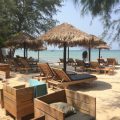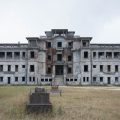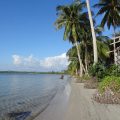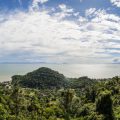Bayon

For other uses, see Bayon (disambiguation).
The Bayon (Khmer: ប្រាសាទបាយ័ន, Prasat Bayon) is a well-known and richly decorated Khmer temple at Angkor in Cambodia. Built in the late 12th or early 13th century as the official state temple of the Mahayana Buddhist King Jayavarman VII, the Bayon stands at the centre of Jayavarman’s capital, Angkor Thom. Following Jayavarman’s death, it was modified and augmented by later Hinduand Theravada Buddhist kings in accordance with their own religious preferences.
The Bayon’s most distinctive feature is the multitude of serene and smiling stone faces on the many towers which jut out from the upper terrace and cluster around its central peak. The temple is known also for two impressive sets of bas-reliefs, which present an unusual combination of mythological, historical, and mundane scenes. The current main conservatory body, the Japanese Government Team for the Safeguarding of Angkor (the JSA) has described the temple as “the most striking expression of the baroque style” of Khmer architecture, as contrasted with the classical style of Angkor Wat.
History
The Bayon was the last state temple to be built at Angkor, and the only Angkorian state temple to be built primarily as a Mahayana Buddhistshrine dedicated to the Buddha, though a great number of minor and local deities were also encompassed as representatives of the various districts and cities of the realm. It was the centrepiece of Jayavarman VII‘s massive program of monumental construction and public works, which was also responsible for the walls and nāga-bridges of Angkor Thom and the temples of Preah Khan, Ta Prohm and Banteay Kdei.
The similarity of the 216 gigantic faces on the temple’s towers to other statues of the king has led many scholars to the conclusion that the faces are representations of Jayavarman VII himself. Others have said that the faces belong to the bodhisattva of compassion called Avalokitesvara or Lokesvara. The two hypotheses need not be regarded as mutually exclusive. Angkor scholar George Coedès has theorized that Jayavarman stood squarely in the tradition of the Khmer monarchs in thinking of himself as a “devaraja” (god-king), the salient difference being that while his predecessors were Hindus and regarded themselves as consubstantial with Shiva and his symbol the lingam, Jayavarman as a Buddhist identified himself with the Buddha and the bodhisattva.
Alterations following the death of Jayavarman VII
Since the time of Jayavarman VII, the Bayon has undergone numerous additions and alterations at the hands of subsequent monarchs. During the reign of Jayavarman VIII in the mid-13th century, the Khmer empire reverted to Hinduism and its state temple was altered accordingly. In later centuries, Theravada Buddhism became the dominant religion, leading to still further changes, before the temple was eventually abandoned to the jungle. Current features which were not part of the original plan include the terrace to the east of the temple, the libraries, the square corners of the inner gallery, and parts of the upper terrace.
Modern restoration
In the first part of the 20th century, the École Française d’Extrême Orient took the lead in the conservation of the temple, restoring it in accordance with the technique of anastylosis. Since 1995 the Japanese Government team for the Safeguarding of Angkor (the JSA) has been the main conservatory body, and has held annual symposia.
Ref: https://en.wikipedia.org/wiki/Bayon
Related Posts
Sihanoukville
A peninsula ringed by pretty whiteish-sand beaches and surrounded by a smattering of very attractive islands, Sihanoukville is...Bokor National Park
Bokor National Park is an unmissable trip out from Kampot. Explore the romantic, highly atmospheric old casino —...Botum Sakor National Park
Occupying almost the entirety of the 35km-wide peninsula northwest across the Gulf of Kompong Som from Sihanoukville, this...Kep National Park
The interior of Kep peninsula is occupied by Kep National Park, where an 8km circuit, navigable by foot...




